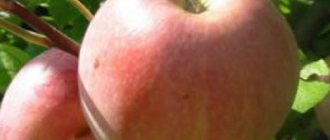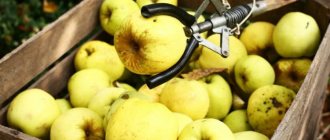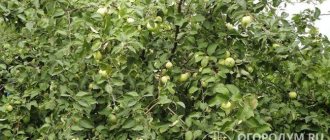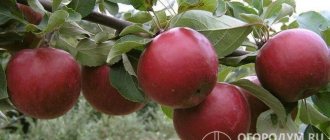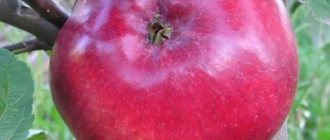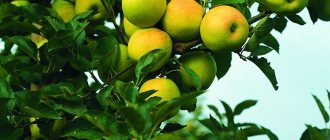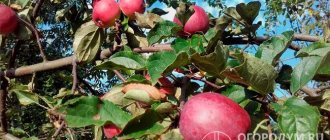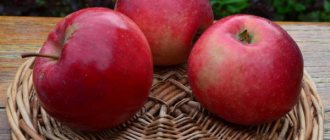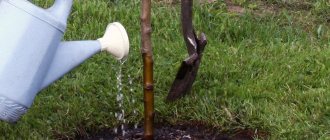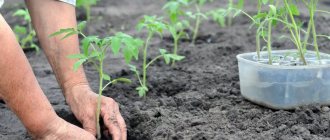Gardeners take into account many factors when choosing varieties of apple trees for a plot: the ripening time and taste of apples, the height of the tree and the rules for caring for it, the frost resistance of apple trees and various other indicators. The Uslada apple tree variety has been chosen by many summer residents for their gardens due to its excellent characteristics.
This variety has proven itself well in the central regions of Russia, as it winters well and ripens in areas with rainy summer periods.
Description of the apple tree variety Uslada
The maximum height of the tree is 3 m; timely pruning allows you to correctly form the crown and achieve the desired height. Young seedlings have a rounded crown; as it grows, it begins to stretch out and takes on the appearance of a regular oval.
The trunk and branches of the tree are dark gray in color, the buds are tightly pressed to the shoots. The leaves are ovoid, large, slightly curled downwards on the underside.
The first harvest can begin 4 years after planting the seedlings in open ground in a permanent place of growth. According to gardeners, the yield level is quite high, but to obtain it requires annual formation of the crown and proper care.
Region of natural growth
As we have already mentioned, the Uslada apple tree primarily lives in the European part of Russia .
However, thanks to its excellent winter hardiness and endurance, Uslada can take root well in other regions. This apple tree is especially good for those parts of the country where cold and rainy summers are often observed - the resistance to scab disease in such trees is extremely high.
In general, this variety is quite unpretentious and hardy, so even novice gardeners can grow such a tree .
Taste qualities of the Uslada apple variety
The weight of a ripe fruit varies from 100 to 200 g. Apples are round in shape, in some cases they can be oval, and there are no ribs. The peel is quite thin, but at the same time elastic. The main color is green-yellow, the top color is red-crimson. You can see small light dots under the skin.
Uslada apples have a sweet and sour taste with a raspberry aftertaste. The internal color of the ripe fruit is white, sometimes soft pink apples are found. The pulp is juicy, dense, tender, the grains are small. After the apples are ripe, they do not fall off - they remain hanging on the branches of the tree, holding tightly to the cuttings.
Harvest and storage
Late harvest is sweetest
The entire harvest must be harvested by early September. The later the fruits are picked, the sweeter they are.
Apples can be stored for 4-5 months. Ripe fruits can be kept in a cool room with good ventilation until January. Fruit picked in mid-July can last until March.
Fresh apples should be stored on racks lined with straw so that the fruits do not come into contact with each other. You can keep the harvest in wooden boxes, with sheets of cardboard placed between the fruits.
Pros and cons of the Uslada apple tree variety
According to the description, photos and reviews of planting the Uslada apple tree, it is necessary to take into account that the variety has a certain number of advantages and disadvantages. The advantages of the Uslada apple tree include:
- early fruit ripening;
- high level of productivity;
- annual fruiting;
- the versatility of the fruit – suitable for canning, long-term storage, and fresh consumption;
- excellent taste;
- attractive appearance;
- ripe fruits contain a large amount of vitamins;
- high level of resistance to low temperatures;
- The Uslada apple tree is resistant to a large number of diseases.
As practice shows, no significant deficiencies have been found in the variety; the only thing that is required is to trim the crown, as it is quite thick.
Important! If pruning is done poorly, the yield decreases and the fruits grow in different sizes.
Main advantages of the variety
Professional gardeners and amateur summer residents name among the advantages of Uslada:
- decent taste and presentation of fruits;
- long shelf life of the crop and the ability to transport it over long distances;
- high precocity of trees;
- regularity of fruiting, stable yield;
- winter hardiness not inferior to “Antonovka ordinary”;
- adaptability to the climate of central Russia;
- unpretentiousness and relative resistance to disease - mild scab damage to fruits and leaves.
According to experienced gardeners, “Uslada” is affected by pests at the level of standard varieties, and by scab to a weak degree – 0.5-1.0 points out of 5; Depending on weather conditions, it exhibits resistance to various fungal diseases. You can learn in detail about the nature of these ailments and various ways to combat them from the article “How to treat apple trees in early spring against pests and diseases.”
The good consumer qualities of apples, their transportability and keeping quality have made the variety in demand in industrial fruit growing
Easily correctable, but requiring attention and labor costs, negative features of Uslada include the self-sterility of trees and the dependence of fruit size on the degree of crown density.
Planting and caring for the autumn apple tree Uslada
To obtain a high yield, it is necessary to correctly carry out the planting and further care of the tree. It is recommended to plant apple trees in open ground in early spring or mid-September - early October. It is necessary to maintain the permissible distance between seedlings, which varies from 4 to 5 m.
During the growth process, seedlings need to be watered in a timely manner, fertilize and fertilize, form a crown, and carry out preventive work, thanks to which the appearance of pests and many diseases can be prevented. To ensure a high harvest, the tree crown is formed annually.
Selection and preparation of a landing site
A high yield from the Uslada apple tree can only be achieved if high-quality care is provided, which also includes the selection and preparation of land for planting planting material in open ground. The selected area must be well lit, since apple trees are light-loving trees and also protected from winds.
The best option for planting trees would be chernozem soils, light sandy loams and loams. This choice is due to the fact that the soils are well aerated, as a result the root system receives the required amount of oxygen. Heavy soils are quite acidic and wet, which is why trees growing on such lands are more likely to be susceptible to disease.
Attention! It is not recommended to plant the Uslada apple tree variety on soils where there is close groundwater.
Seedling preparation
Seedlings for planting should be selected carefully, paying special attention to this process. It is recommended to purchase planting material at the very moment when you plan to plant trees in open ground. If it was decided to purchase seedlings in advance, it is best to choose trees with a closed root system. It is necessary to pay attention to the trunk and shoots, they must be strong, without mechanical damage. The root system should be elastic and moist. For better survival, you can use rooting agents; for this, before planting, the roots of the tree are soaked for several hours in a special product.
Landing rules
After studying general information about the Uslada apple variety, looking at the photo and description of the variety, you need to familiarize yourself with how to properly plant a purchased seedling in open ground. The process of planting apple trees of the Uslada variety is as follows:
- Dig a hole measuring 70x50 cm (depth x width).
- The bottom of the pit is loosened.
- Then add 10 liters of fertile soil, 20 liters of humus, 5 kg of peat, 25 g of superphosphate, 15 g of nitrogen and potassium fertilizers.
- To make the seedling stable, you can pre-install a support - pegs.
- Before planting a tree in open ground, you must first pour 10 liters of water into the planting hole.
- A tree is planted on a mound of nutritious soil mixture, carefully distributing the roots.
- Cover with the remaining soil.
- Pack tightly.
- After the planting process is completed, the apple tree is watered and the soil around it is mulched.
Watering and fertilizing
The Uslada variety apple tree must be watered regularly. The frequency for a seedling is once every 7 days. The soil under the tree should always be moist and loose. If the summer turns out to be dry, then the frequency and amount of watering is increased. Weeds that appear in the root circle are removed. To retain moisture, it is best to mulch the soil.
It is recommended to use organic matter and minerals as fertilizing. Every year in early autumn per 1 sq. m need to be poured under the trees:
- Rotted cow manure – 5 kg.
- Bird droppings – 1 kg.
- Compost – 8 kg.
At the time of flowering, nutritious fertilizers are applied, mainly liquid fertilizers. A trench up to 30 cm deep is made around the trunk, into which organic matter is poured, for example, slurry or chicken droppings.
Advice! A young tree needs about 20 liters of water, an adult plant – 30 liters.
Trimming
Pruning is an equally important step in the process of growing an Uslada apple tree. When performing the procedure, you should not leave untreated stumps. Dry branches are removed so that a small amount of living tissue is captured. The cut area is cleaned with a knife and treated with garden varnish.
If you plan to thin out the crown, then you need to take into account one important feature - the branches should not touch each other, much less grow inward. After pruning, the sun's rays should penetrate the crown of the Uslada apple tree.
Important! Tree pruning work must be completed before the sap begins to flow; it is not recommended to carry out these manipulations with the apple tree in the fall.
Preparing for winter
Despite the fact that the Uslada apple tree can withstand low temperatures, many gardeners prefer to cover the trees for the winter, as a result of which the trunk can be protected from rodents and insects.
For shelter use:
- roofing felt;
- parchment;
- mesh;
- spruce and pine paws;
- roofing felt
In addition to these materials, you can use lime or naphthalene. Thanks to whitewashing, you can protect the tree trunk not only from rodents, but also from a number of pests and sunburn.
Attention! If you provide the Variety Uslada apple tree with proper care, the yield and taste of ripe fruits will be good.
Reviews from gardeners
Rostislav, 51 years old, Leningrad region
The variety is certainly not for couch potatoes. To ensure that the apples are not only beautiful and tasty, but also large, it is impossible to ignore pruning. Every spring I thin out the crown, removing poorly located and unnecessary branches, as well as those that intertwine with each other. And the shorter the growth of the last year, the more I shorten the branch. I immediately treat cut areas with a diameter of more than 1 cm with wound-healing paste “Ethisso Lac Balsam” or a self-prepared mixture based on drying oil.
Yuri, 43 years old, Vologda
Our Uslada is about ten years old. It overwinters well (I didn’t even cover the seedling), and practically does not get sick. I bought the tree at a local nursery, specially choosing an autumn variety adapted to our climate. In terms of productivity, the apple tree suits me - it bears fruit every year and produces at least 50 kg per season. The longer the apples remain on the tree, the tastier they become. We mainly preserve the fruits for the winter, evaporate most of them in a juicer, the juice turns out wonderful.
Ruslana, 45 years old, Moscow region
The apples really grow large and beautiful, but the taste, for me personally, leaves much to be desired - there is not enough sweetness and aroma. Unfortunately, in damp summer the fruits gain juiciness, but they turn out generally bland, and they are not stored very well.
The ripening period of the Uslada apple tree
The flowering process of the Uslada apple tree occurs at the end of spring - beginning of summer. Bright, delicate and fragrant flowers completely cover the fruit tree in early June.
The fruiting phase begins after the tree reaches five years of age. Compared with other varieties, the harvest comes quite quickly.
In mid-summer you can eat the first apples; at this time the taste of the fruit is sour. A sufficient amount of sugar accumulates at the end of summer, it is during this period that the ripening process is completed. At the beginning of September they begin to harvest the finished crop.
Ripening and fruiting
- Flowering begins in the last days of spring, the tree is completely covered with rich, delicate flowers with a pleasant aroma by the 2nd week of June.
- The variety begins to bear fruit in the fourth or fifth year, which is quite fast when compared with other varieties that produce large fruits.
- The fruit can be eaten from the middle of the summer season if you like the sourness in it. But apples gain more sugar content towards the last days of summer, at which time they ripen. The harvest is harvested in September.
- Fruits can be stored until the last days of January, and if they are picked early, until the last days of winter.
Diseases and pests
If we take into account the description and reviews of gardeners who have already been lucky enough to grow Uslada apple trees on their plots, we can say that this variety is resistant to pests and a number of diseases. Timely treatment with drugs is the best disease prevention.
In early spring, when the buds on the trees are still closed, Bordeaux mixture can be used. The crown and trunk are sprayed with a solution containing lime and copper sulfate. After bud break, insecticides are used for treatment.
Advice! As additional protection against diseases and pests, it is recommended to promptly remove fallen leaves, weeds and debris around apple trees, and dig up the tree trunk circle.
Varieties of cultivation
Columnar.
- There is no such variety of this variety.
- General characteristics of apple trees of this species.
- Such apple trees require constant care. It all starts with planting, which requires the formation of a root system, and ends with regular pruning.
- This type helps gardeners if there is not enough free space on their site.
Dwarf rootstock.
- You can grow the variety on a dwarf rootstock if you need to accelerate the onset of fruiting, as well as to increase resistance to frost and immunity to scab.
- This type is cultivated in areas with harsh climatic conditions and low temperatures in winter.
Clonal rootstock.
Clonal rootstock can stably inherit genetics, which is different from seed rootstock. This is very important if it is necessary to grow apple trees with certain properties.
Reviews about the Uslada Isaeva apple tree
Elizaveta Barinova, 50 years old, Moscow
I have been growing Uslada apple trees on my plot for 6 years now. Unfortunately, the yield level is not what we would like, but the ripe fruits are always large, since the trees grow on black soil. The height of the tree is small, the crown is oval. The variety is unpretentious in care; preventive measures using insecticides are sufficient and there are no diseases or pests.
Svyatoslav Trubin, 48 years old, Novosibirsk
When growing Uslada apple trees, the most difficult thing is the pruning process, but if you get used to it, there will be no problems. I noticed that the variety adapts quite easily to any climatic conditions, the survival rate is excellent. Uslada has been growing on my site for more than 10 years. During the first pruning, I gave the crown an oval shape and maintain it in the same shape every year. I like the taste of apples: sweet and sour, with a raspberry aftertaste.
Features of cultivation in the regions
To avoid problems when growing in regions, it is important to take into account some features of the Uslada variety.
Leningrad region and North-West Russia
Uslada has adapted well to this region, despite the high rainfall and few sunny, warm days in the summer, thanks to its good resistance to scab.
Moscow region
The conditions in this region are suitable for growing the Uslada variety. It bears fruit well in fertile soils, and its viability helps it adapt to local weather conditions.
Siberia
Although the variety is winter-hardy, the dwarf frost-resistant Uslada apple tree is well suited for growing in the harsh conditions of Siberia.
Apple fruits
https://www.youtube.com/watch?v=jRF2UgadGI4
You can start consuming the Uslada apple variety in mid-summer: they have a sour taste. When picked at ripeness in September, they become sweet and aromatic.
The timing of flowering and fruiting of an apple tree approximately depends on the weather conditions in the planting region.
Bloom
Usually Uslada begins to bloom at the end of May and this period continues until mid-June. The apple tree seems to be strewn with delicate, fragrant flowers.
Beginning of fruiting
The tree begins to bear fruit 4-5 years after planting. This is early enough for large-fruited apple varieties.
Apples begin to ripen at the end of August; if picked at this time, they will be stored until February.
The main fruit harvest occurs at the end of September, when the apples acquire a sweet taste with a raspberry aftertaste. Due to the fact that apples hang on the tree for a long time and do not fall off, the harvest can be harvested in 2-3 steps. Fruits collected at this time can be stored until January.
They tolerate transportation well, and their taste makes them universal in use.
Ripe apples.
Ripe apples weigh from one hundred to one hundred and thirty grams, sometimes their weight reaches two hundred grams. Apples are round, can be oval, smooth, and have no ribs. The skin is not thick, elastic. The fruits are green-yellow, sometimes with raspberry-red shades. On some apples you can see faint stripes and a pronounced blush. Small light dots are visible under the skin.
The sweet and sour fruits have a slight taste and aroma of raspberries. The pulp is white, in some fruits pale pink, non-grainy, juicy and dense, aromatic. When the fruits are fully ripe, they do not fall to the ground, but are located on the branches, as they have strong cuttings. If you harvest an unripe crop, you can save it until mid-winter.
Overripe and ripe fruits must be eaten or processed within 30 days or they may spoil.
The main disadvantage of Uslada is that the gardener will have to trim the tree’s crown every year. If he does not do this, it will become very thick and the yield of the plant will decrease. It will not develop fully, the fruits will lose their attractive appearance.
This variety received its name, of course, not in vain. The apples on Uslada grow really very sweet and aromatic. The main color of the skin of the fruits of this variety is green, and the outer color is red (with blurred stripes). The pulp of ripe Uslada apples is mostly yellow-green. Only in some places it may have a pink tint. In any case, the pulp of the fruits of this variety is quite dense and at the same time very juicy.
In addition to their excellent taste, Uslad apples are also characterized by the fact that they contain a very large amount of vitamins. Therefore, they are recommended also for children’s and dietary nutrition. For example, the fruits of this variety contain almost 2 times more vitamin C than the famous Antonovka. The taste of apples of this variety is sweet, with sourness and a raspberry tint.
READ MORE: Tomato Tanya characteristics and description of the variety, yield with photos
Uslada apples can be used both for fresh consumption and for canning. Compotes, preserves and jams made from them are very tasty. However, the fruits of this variety themselves, unfortunately, are not stored for too long. It is recommended to eat them within a maximum of a month after harvest.
Above, the reader can see a close-up of the fruit of the Uslada apple tree in the photo. The description given to these apples above in the article, as well as reviews from summer residents, allow us to judge them as very tasty
However, the fruits of this variety have another important advantage. Uslada apples, among other things, also look very attractive
Therefore, the variety is also considered commercial. The fruits of this apple tree can also be used for sale. In addition, their transportability is relatively good.
Care
The apple tree is undemanding in care. It is necessary to carry out standard procedures for fruit crops:
- watering. The seedlings need to be irrigated as the top part of the soil dries. Watering of mature trees after winter begins during the formation of buds and continues until November. The frequency of moisturizing is every 14 days, the amount is 15 liters. It is necessary to water the tree at the root;
- fertilizing In spring, ammonium nitrate is added. In autumn, the tree needs phosphorus-potassium mixtures; they are scattered into specially dug grooves along the perimeter of the crown;
- pruning and crown formation. Due to its high shoot-forming ability, the tree needs pruning. In the spring, before the juices begin to flow, remove all shoots that will not bear fruit. Also cut off branches that grow inward, are old and frozen. The procedure is carried out with a sharp instrument, and the sections must be treated with garden varnish.
Platovsky grapes: variety description, growing guide
In dry, hot summers, Uslada apple trees need more frequent watering. After harvesting, before winter, the soil around the trunk must be carefully dug up and potassium fertilizers applied. It is recommended to wrap the apple tree trunk with roofing material to protect it from pests.
Characteristic
The tree is medium-sized. The crown of a young apple tree is rounded, becoming more elongated over time. The leaves are ovoid, pointed, and have a bright green color.
The description indicates that the fruits of the variety are medium in size. The surface is smooth, yellow-green in color with a delicate pink blush. The taste of apples is sweet, with berry notes. The flesh is crispy and juicy.
Advantages and disadvantages of the variety
Experienced gardeners highlight the following advantages of the variety:
- miniature, easy to care for;
- high yield even in unfavorable weather conditions;
- high frost resistance;
- good taste and marketability of apples;
- high resistance to fungal diseases and pests.
Uslada apple trees have a high shoot-forming ability. Many people call it a disadvantage because the crown has to be trimmed more often. The ripe fruits of the variety are very tender and are not suitable for long-term storage. The variety has no other disadvantages.
Productivity
The tree bears its first fruits 4-5 years after planting. Productivity is consistently high even with high rainfall.
According to the description, 60-80 kg of apples can be harvested from one mature tree per season. Indicators depend on the terrain, soil composition, and maintenance.
Self-fertility
Uslada is a self-sterile variety. Cross pollination is necessary for fruit to appear on a tree.
There should be pollinators near this type of apple tree. The following varieties are used: Grushovka, Orlik, Bogatyr, President.
Winter hardiness
Uslada is a frost-resistant variety. Even young trees can withstand sudden temperature changes.
In winter, the apple tree tolerates frosts down to -25 °C. This allows it to be grown in different regions of Russia.
Advantages and disadvantages
Amateurs and experienced gardeners have already appreciated the obvious advantages of the Uslada apple tree, the name of which speaks for itself:
- not afraid of cold and severe frosts;
- resistant to diseases (including scab) and pests;
- not afraid of wet soil;
- an annual rich harvest with proper care (the variety can also be used for commercial cultivation);
- high-vitamin fruits;
- It does not require special care.
When planning to plant this variety of apple tree on your plot, it is worth remembering only a few features of its cultivation to obtain a uniform harvest - annual pruning of the thickened crown and the presence of pollinating varieties in the neighborhood. By properly caring for the tree, the owner of the garden will annually receive delicious apples with a soft raspberry aroma. At the same time, they will not only delight you with their taste, but will be beneficial for the body - due to their high content of nutrients, apples are suitable even for dietary nutrition.
